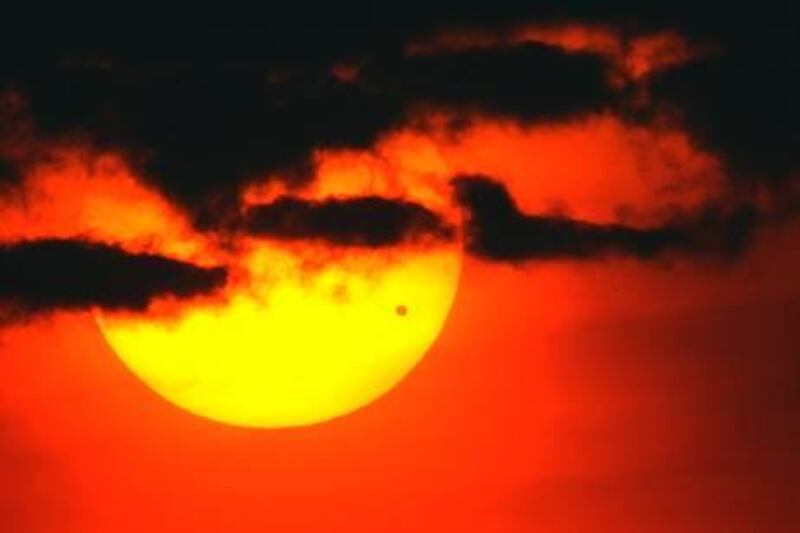Sunrise on Wednesday will be like no other for the next 100 years and more. The event is one for which astronomers around the world have long prepared, in the knowledge that there will not be another until December 2117.
Not that most of us down here on Earth will notice anything unusual when the Sun rises over the UAE shortly after 5.30am.
But anyone with a small telescope able to project an image of the Sun - or viewing the website given below - will see a black dot slowly moving across the solar disc as the planet Venus performs a rare celestial manoeuvre known as a solar transit.
Such an alignment of the Sun, Earth and its nearest planetary neighbour has been witnessed only six times in recorded history.
As astronomical phenomena go, it has none of the drama of an eclipse of the Sun. Yet past observations of these seemingly trivial events transformed our knowledge of the cosmos - and now, in a new guise, are doing so again.
Despite being practitioners of the oldest of the sciences, astronomers took a surprisingly long time to realise the importance of solar transits.
German astronomer Johannes Kepler published the first calculations of such events in the 17th century, and the earliest known observations of transits of Mercury and Venus were made in the 1630s.
But it was not until 1663 that a Scots polymath named James Gregory understood the cosmic insight that could be extracted from them.
For as long as people have stared into the night sky, there has been a suspicion that we humans are at the centre of immensities. Yet until the then 24-year-old Gregory's insight, there seemed little hope of gauging their scale.
He realised that each transit would look slightly different from different points on the Earth, and that analysis of the differences could reveal something previously only guessed at: the distance between the Earth and its parent star.
The first astronomer known to have tried to estimate this distance was Aristarchus of Samos, around 2,300 years ago, using observations of eclipses and phases of the moon.
Simple geometry led him to a rough estimate that the Sun is around 19 times further away than the Moon - very rough, in fact, as the true figure is 20 times greater still.
Gregory's method promised to reveal the scale of the solar system with far more precision. Unfortunately, suitable transits occur only around once a century, and it was not until almost a century after his death, at just 36, that astronomers were able to put his idea into action.
In what is regarded as the first international scientific collaboration, teams from across Europe prepared to observe the transits of Venus of 1761 and 1769. (The transits always occur in pairs, separated by around eight years. The last was in 2004.)
The first attempt was only a qualified success, putting huge pressure on astronomers to do better in 1769. They knew it would be 105 years before they had another chance. The British entrusted their effortto the great marine explorer Captain James Cook, who was sent to Tahiti to make observations.
The success of his mission was deemed so important that even the government of France, which had recently been at war with England, instructed its navy to allow Cook to travelunhindered to his destination.
It was worth the effort. The observations revealed the distance between the Earth and the Sun - the so-called Astronomical Unit - to be between 152 and 154 million kilometres, within 2 per cent of the modern figure.
Using more sophisticated analysis, astronomers later arrived at a figure of 149.7 million km - within 100,000km of the modern value.
Suddenly the true size of the solar system was revealed. Simple calculations had already shown that Saturn - the most distant of the planets easily visible to the naked eye - is around 10 times further from the Sun than the Earth.
Plugging in the figure from the transit of Venus, astronomers now realised that when they looked at this planet, they were viewing a colossal celestial object more than 1.3 billion kilometres away.
More revelations followed. In the 19th century, astronomers measured the distances to the nearest stars using a method that gave results in terms of the distance of the Earth to the Sun.
Even the closest stars were found to be more than 260,000 times further away than the Sun, which the transit results converted into a distance of 40 million million km.
Then, this was a far vaster distance than anyone imagined; even today it is hardly comprehensible.
Gregory's method has long been superseded as a means of measuring planetary distances. Radar beams bounced off our celestial neighbours have now pinned down the distance of the Sun to 149,597,870.700 kilometres, give or take just a few metres.
But transits have found a new, and no less spectacular use: detecting the presence of planets around other stars.
In 2009, Nasa launched Kepler, a space observatory that keeps around 100,000 stars under constant watch. It is looking for tiny dips in the light, caused by planets transiting their parent stars.
So sensitive are Kepler's detectors that they can pick up dips in brightness equivalent to a single porch-light being switched off in a small town. So far, it has found evidence for more than 1,000 planets.
Astronomers now plan to use this Wednesday's transit to test their ideas for detecting the presence of atmospheres around other planets. Their aim is to enable Kepler to spot Earth-like worlds, and thus speed the search for alien life.
Who knows, perhaps alien astronomers will also be watching our sun on Wednesday, and notice the tell-tale dip in light that will tell them that they too are not alone.
Robert Matthews is visiting reader in science at Aston University, Birmingham England
Watch the transit of Venus on Wednesday morning at http://events.slooh.com/






